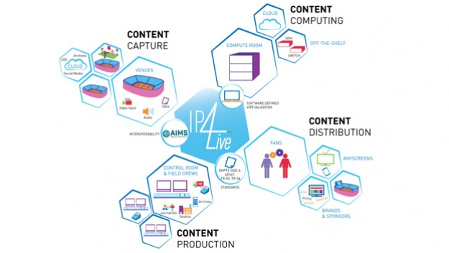The Great IP Migration: Where are We on the Journey?
LIÈGE, BELGIUM—With facilities under growing pressure to deliver more content while at the same time needing to cut costs, manufacturers are developing more and more tools that make the high-intensity live production environment easier, faster or more efficient.

As the world of content distribution has exploded with more channels, more enriched programming and the introduction of digital platforms as secondary – or increasingly, primary – media consumption devices, it’s important for those content owners to be able to produce the best possible programming with the most effective resources.
And that’s why the migration to IP is so important. There’s no shortage of articles, presentations or product messaging that tells us the benefits of migrating from SDI to IP infrastructures. Live production is the ‘next frontier’ that will benefit from IP connectivity. Once a migration to IP is complete, the industry as a whole will be able to do more as workflows won’t be restricted any longer by the limits of SDI and other similar signal flow methods.
OVERCOMING LIMITATIONS
SDI is point-to-point while IP enables multipoint connections. SDI moves data in one direction while IP is bidirectional. As SDI is moving one signal at a time, IP can handle multiple.
That’s not to say SDI hasn’t served us well for many years. I’ve worked a large portion of my professional life with SDI connectivity and it’s done some pretty outstanding - even revolutionary -things. And from the EVS point of view, and our IP4Live initiative, the move from SDI to IP must be an evolution rather than a revolution.
And the importance of this transition isn’t lost on broadcasters or content producers. In a recent survey of broadcasters by Devoncroft, the top five things that are on the minds of producers are either dependant or reliant on the update of IP-enabled infrastructures. These topics include IP networking and content delivery itself, multi-platform content delivery, file-based or tapeless workflows, virtualisation and 4K/UHD.
All of these things will benefit from the implementation of IP, and that’s why some of the largest technology providers in the industry have come together to form industry bodies such as the Alliance for IP Media Solutions (AIMS). The goal of industry-led groups is to accelerate and promote the open standards that broadcast and media companies use to move from SDI systems to an IP-based future – enabling all of the benefits it will bring.
And this is where we are with the transition from SDI to IP. There needs to be interoperability between the industry’s leading technology providers in order for any kind of transition to take place. This is perhaps best seen when it comes to standards. Collectives like AIMS bring together broadcasters, technology providers and industry standards organisations to eliminate the fragmentation that multiple flavours of IP bring. In addition, these organisations are helping to uncover the real-world use cases and ensure that the standards and recommendations for development will address these needs.
The Sandbox+ project run by the EBU and VRT in Belgium is a great example of what can be done in a fully-IP environment. The LiveIP studio - built at VRT’s production centre in Brussels – is a technology demonstration of many of the industry’s leading solution providers connected entirely by IP infrastructures. After extensive tests, the LiveIP studio has recently started producing and distributing programming for Ketnet, VRT’s children’s channel. This project is a clear significant step toward putting the benefits of fully-IP infrastructures into daily on-air production.
A STEADY, HYBRID TRANSITION
Even though pioneering projects like the Sandbox+ LiveIP studio demonstrate that this is possible, it’s highly unlikely that any broadcaster will start from scratch and implement an entirely IP-based infrastructure. The step we need to see next – and the step we will absolutely see – is a hybrid approach to the adoption of IP. Anyone upgrading to any form of IP-enabled workflow needs to continue to protect the investments they’ve made in SDI-based technology. While in the long-term, the OPEX of IP infrastructures is lower, that’s not to say everyone should use all of their CAPEX to install it.
EVS’ IP4Live initiative was put together to work alongside our clients and customers to show them how the SDI/IP hybrid approach to a transition is the best way to work. With that in mind, alongside our optional gateway solutions for existing live production servers that connect existing SDI-based solutions to IP infrastructures, our new product development and upcoming announcements will feature integrated IP-based options.
When it comes to IP technology, many people say there is plenty of work to be done. But we’re of the opinion that the work that has been done is of the utmost importance, and has significant value today. SDI is by no means dead. IP-enabled technologies will sit alongside SDI to enhance its operation and connect the live production environment.
This post originally appeared on TV Technology's sister publication, TV Technology Europe.
Get the TV Tech Newsletter
The professional video industry's #1 source for news, trends and product and tech information. Sign up below.
